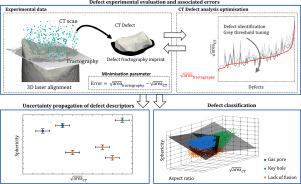Defect analysis by computed tomography in metallic materials: Optimisation, uncertainty quantification and classification
IF 3.7
2区 工程技术
Q2 ENGINEERING, MANUFACTURING
Precision Engineering-Journal of the International Societies for Precision Engineering and Nanotechnology
Pub Date : 2025-09-20
DOI:10.1016/j.precisioneng.2025.09.008
引用次数: 0
Abstract
This paper presents a methodology to optimise post-processing parameters in X-ray Computed Tomography (CT) for defect detection in metallic materials. The approach addresses three main goals: minimisation of systematic errors in defect reconstruction, quantification of uncertainty, and reliable defect classification. The proposed methodology aims to remove the systematic error that impacts defect reconstruction, thereby improving the accuracy of defect size and morphology assessment, which is essential for fatigue life prediction, particularly in materials produced through additive manufacturing (AM). An iterative comparison between CT-based defect and fractographic measurements is involved to identify the optimal CT post-processing parameters, such as the grey threshold (GT). The methodology was applied to 11 dog-bone-shaped titanium alloy samples (5.5 mm nominal gauge diameter) produced via electron beam melting. The optimisation procedure resulted in a GT value that was 134% of that obtained using a commercial algorithm, effectively removing the systematic uncertainty associated with Murakami’s parameter . The uncertainty of various defect features, such as equivalent diameter, sphericity and aspect ratio, was calculated by propagating the remaining stochastic uncertainty of . An unsupervised K-means algorithm categorised unlabelled defects into three major types often encountered in AM: gas pores, keyholes, and lack of fusion. Finally, the labelled defects were processed through a support vector machine to infer the analytical form of the decision boundaries, achieving an accuracy of 99%.

金属材料的计算机断层扫描缺陷分析:优化、不确定度量化和分类
本文提出了一种优化金属材料缺陷检测中x射线计算机断层扫描(CT)后处理参数的方法。该方法有三个主要目标:缺陷重建中的系统误差最小化,不确定性的量化,以及可靠的缺陷分类。提出的方法旨在消除影响缺陷重建的系统误差,从而提高缺陷尺寸和形态评估的准确性,这对于疲劳寿命预测至关重要,特别是在通过增材制造(AM)生产的材料中。基于CT的缺陷测量和断口测量之间的迭代比较涉及到确定最佳CT后处理参数,如灰色阈值(GT)。将该方法应用于电子束熔化法制备的11个狗骨型钛合金样品(公称规径5.5 mm)。优化程序产生的GT值是使用商业算法获得的值的134%,有效地消除了与村上参数面积相关的系统不确定性。通过传播剩余的面积随机不确定性,计算出等效直径、球度和纵横比等缺陷特征的不确定性。一种无监督K-means算法将未标记缺陷分为AM中经常遇到的三种主要类型:气孔、锁孔和缺乏融合。最后,通过支持向量机对标记的缺陷进行处理,推断出决策边界的解析形式,准确率达到99%。
本文章由计算机程序翻译,如有差异,请以英文原文为准。
求助全文
约1分钟内获得全文
求助全文
来源期刊
CiteScore
7.40
自引率
5.60%
发文量
177
审稿时长
46 days
期刊介绍:
Precision Engineering - Journal of the International Societies for Precision Engineering and Nanotechnology is devoted to the multidisciplinary study and practice of high accuracy engineering, metrology, and manufacturing. The journal takes an integrated approach to all subjects related to research, design, manufacture, performance validation, and application of high precision machines, instruments, and components, including fundamental and applied research and development in manufacturing processes, fabrication technology, and advanced measurement science. The scope includes precision-engineered systems and supporting metrology over the full range of length scales, from atom-based nanotechnology and advanced lithographic technology to large-scale systems, including optical and radio telescopes and macrometrology.

 求助内容:
求助内容: 应助结果提醒方式:
应助结果提醒方式:


